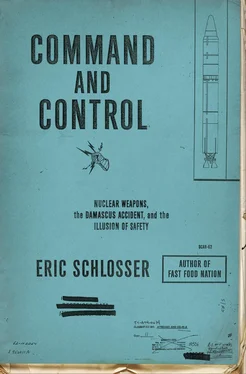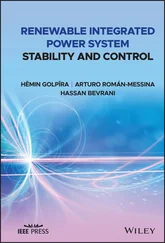The Trinity test had been preceded by weeks of careful preparation, and every effort had been made to control the outcome. The device had been slowly and patiently assembled. The wiring and explosives had been repeatedly checked. The tower had been built, the location of the test chosen, and each step of the countdown arranged as part of an elaborate, scientific experiment. Turning an experimental device into an operable weapon presented a new set of challenges. Atomic bombs had to be dropped, somehow, and American aircrews had to survive the detonations. B-29 bombers were secretly retrofitted so that nuclear weapons would fit inside them. And pilots were secretly recruited to fly these “Silverplate” B-29s. They practiced dropping dummy bombs, then banking steeply to escape the blast. Enough fissile material for two nuclear weapons — a gun-type device loaded with uranium-235 and an implosion device with a plutonium core — were readied for use against Japan. The arming and fuzing mechanisms of the bombs would determine when they exploded, whether they exploded, and how much time the bomber crews would have to get as far away as possible.
Both designs relied on the same three-stage fuzing system. When a bomb was released at an altitude of about 30,000 feet, arming wires that linked it to the plane would be pulled out, starting a bank of spring-wound, mechanical clocks inside the weapon. After fifteen seconds, the clocks would close an electrical switch and send power to the firing circuits. At an altitude of 7,000 feet, a set of barometric switches, detecting the change in air pressure, would close another circuit, turning on four radar units, nicknamed “Archies,” that pointed at the ground. When the Archies sensed that the bomb was at an altitude of 1,850 feet, another switch would close and the firing signal would be sent. In the gun-type device, that signal would ignite small bags of cordite, a smokeless gunpowder, and shoot one piece of uranium down the barrel at the other. In the implosion device, the firing signal would set off the X-units. Both bomb types were rigged to detonate about 1,800 feet above the ground. That was the altitude, according to J. Robert Oppenheimer, “appropriate for the maximum demolition of light structures.” Had the bombs been aimed at industrial buildings, instead of homes, the height of the airburst would have been set lower.
The arming and fuzing mechanisms were repeatedly tested at a bombing range in Wendover, Utah. At the end of a successful test the dummy bomb released a puff of smoke. But no amount of practice could eliminate fears that a real atomic bomb might detonate accidentally. Oppenheimer was especially concerned about the risk. “We should like to know whether the takeoff can be arranged,” he wrote to a USAAF liaison officer in 1944, “at such a location that the effects of a nuclear explosion would not be disastrous for the base and the squadron.” The implosion bomb could be inadvertently set off by a fire, a bullet striking an explosive lens, a small error in assembly.
If a B-29 carrying an implosion bomb was forced to return to its base, the president’s Target Committee decided that the crew should jettison the weapon into shallow water from a low altitude. The emergency procedure for a gun-type bomb was more problematic. The gun-type bomb was likely to detonate after a crash into the ocean. Water is a neutron moderator, and its presence inside the bomb would start a chain reaction, regardless of whether the two pieces of uranium slammed together. “No suitable jettisoning ground… has been found,” the committee concluded in May 1945, “which is sufficiently devoid of moisture, which is sufficiently soft that the projectile is sure not to seat from the impact, and which is sufficiently remote from extremely important American installations whose damage by a nuclear explosion would seriously affect the American war effort.” The best advice that the committee could give was hardly reassuring to aircrews, whose bombing runs traversed the Pacific Ocean for thousands of miles: try to remove the cordite charges from the bomb midair and make sure to crash the plane on land.
Captain William S. Parsons was selected to be the “bomb commander and weaponeer” for the first military use of a nuclear weapon. A naval officer who’d spent years researching bomb fuzes, Parsons was chief of the Manhattan Project’s ordnance division. At Los Alamos he’d supervised development of the gun-type bomb, which was to be dropped on the city of Hiroshima. Code-named “Little Boy,” the bomb was ten feet long and weighed about 10,000 pounds. It contained almost all the processed uranium in existence, about 141 pounds. The relative inefficiency of the design was offset by its simplicity. Although a gun-type bomb had never been tested, Oppenheimer assured Parsons that the odds of “a less than optimal performance… are quite small and should be ignored.”
The bomb was assembled in an air-conditioned shed on the island of Tinian, where the Silverplate B-29s of the 509th Composite Group were based. Tinian had the largest, busiest airfield in the world, located 1,300 miles southeast of Tokyo and constructed within months of its capture from the Japanese the previous year. The four main runways were a mile and a half long. At the insistence of General Groves, the Manhattan Project’s dedication to secrecy was so rigorous that even the Army Air Forces officer who commanded Tinian was not told about the atomic bomb or the mission of the unusual B-29s stationed there. Worried that a nuclear accident might kill thousands of American servicemen and destroy an airfield crucial to the war effort, Captain Parsons decided, without informing Groves, that the final steps of assembling Little Boy would not be completed until the plane carrying it had flown a safe distance from the island.
At three in the morning on August 6, 1945, Parsons and another weaponeer, Morris Jeppson, left the cockpit and climbed into the bomb bay of a B-29 named Enola Gay , after the pilot’s mother. The plane was flying at an altitude of five thousand feet, about sixty miles off the coast of Tinian. After making sure that three green safing plugs were inserted into the bomb, Parsons unscrewed the back of it while Jeppson held a flashlight and air turbulence bounced the plane. Nobody had ever done this procedure to a weapon containing fissile material, let alone to one dangling from a single hook in a darkened bomb bay. The men kneeled on a narrow aluminum platform that had been installed the previous day. It took Parsons about twenty minutes to put four small silk bags of cordite into the breech of the gun barrel, reattach the primer wires, and close the back of the bomb. Four and a half hours later, Jeppson returned to the bomb bay alone. The plane was now at about nine thousand feet, nearing the coast of Japan, and the bomb bay felt a lot colder. The green safing plugs blocked the electrical circuit between the fuzing system and the cordite. Jeppson replaced them with red arming plugs. Little Boy was now fully armed, drawing power from its own batteries and not from the plane.
The city of Hiroshima spread across half a dozen islands in the delta of the Ota River. Much of the population had fled to the countryside, leaving about three hundred thousand people in town. The aiming point for Little Boy was the Aioi Bridge, far from the industrial plants on the other islands. The bridge lay in the heart of the city, near the headquarters of the Second Army, amid a residential and commercial district. The bomb was dropped from the Enola Gay at about 8:16 A.M., fell for about forty-four seconds, and detonated at an altitude of roughly 1,900 feet.
At ground zero, directly beneath the airburst, the temperature reached perhaps 10,000 degrees Fahrenheit. Everyone on the bridge was incinerated, and hundreds of fires were ignited. The blast wave flattened buildings, a firestorm engulfed the city, and a mushroom cloud rose almost ten miles into the sky. From the plane, Hiroshima looked like a roiling, bubbling sea of black smoke and fire. A small amount of fissile material was responsible for the devastation; 98.62 percent of the uranium in Little Boy was blown apart before it could become supercritical. Only 1.38 percent actually fissioned, and most of that uranium was transformed into dozens of lighter elements. About eighty thousand people were killed in Hiroshima and more than two thirds of the buildings were destroyed because 0.7 gram of uranium-235 was turned into pure energy. A dollar bill weighs more than that.
Читать дальше












